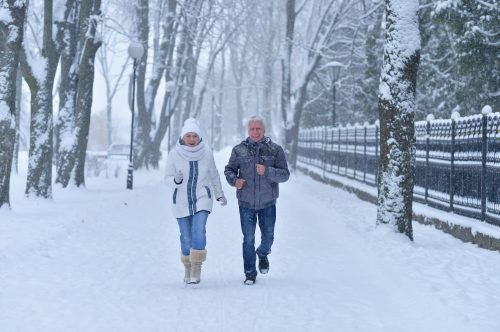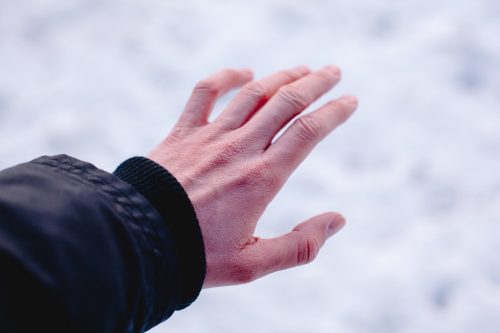"Coldest in Decades" Polar Vortex Hitting the Northeast—How to Stay Safe
Temperatures are set to drop as low as minus 50 degrees in some places.

This winter season in the U.S. has been unusual, to say the least. A deadly ice storm hit Southern states, while places like New York City have seen almost no snow at all. Now, an arctic blast is headed for the Northeast over the weekend, and it's bringing more than typical cold winter weather. In fact, experts have warned that the polar vortex could bring about temperatures that are the "coldest felt in decades." Read on to find out how you can stay safe as the chill sets in.
READ THIS NEXT: 8 Tips to Prepare for a Winter Power Outage, According to Experts.
Winter storms in the South have already turned deadly.

As the North is preparing for a portal vortex, the South is finally nearing the end of its own severe winter weather. From Texas to Arkansas, freezing rain and ice has been pummeling the South this past week.
The icy weather system, named Winter Storm Mara by The Weather Channel, started winding down on Feb. 2—but not before causing deadly damage. The ice storm resulted in treacherous road conditions and more than 400,000 power outages across states like Texas, Arkansas, Mississippi, and Tennessee.
At least 10 deaths are being blamed on Winter Storm Mara because of vehicle crashes. According to The Weather Channel, icy road conditions from the storm contributed to seven deaths in Texas, two in Oklahoma, and one in Arkansas.
Now, the Northeast is preparing for its own dangerous conditions.
Severe winter weather is hitting the Northeast.

On the morning of Feb. 3, a polar vortex started to descend on New England, Axios reported. According to the news outlet, this cold front is expected to last through the weekend, with wind chills likely to bring temperatures down significantly.
"Nearly 100 million Americans will start their day below 20 degrees on Friday and 140 million will on Saturday," CBS News weather producer David Parkinson said.
In light of the cold winds and sub-zero temperatures approaching, more than 15 million people in the Northeast are already under wind chill alerts, CNN reported. The alerts currently cover all of Maine, New Hampshire, Vermont, Massachusetts, Rhode Island, and Connecticut, according to the news outlet. Northern New Jersey, Northeast Pennsylvania, and much of New York state are also under alerts as well.
RELATED: For more up-to-date information, sign up for our daily newsletter.
"Coldest felt in decades" temperatures are expected in many areas.

You might think you can handle the cold, but this won't be like anything you've felt in recent years—or possibly ever. Experts are predicting that many places will experience record-low temperatures during this portal vortex.
"The core of the cold will pass over the Northeast and more specifically, northern New England," the National Weather Service (NWS) said in a forecast discussion, per Axios. "Wind chills into the minus 50s for northern parts of this region could be the coldest felt in decades."
Forecasters at the Weather Prediction Center's Portland, Main, office confirmed this as well: "If wind chills fall to minus 40 or minus 50, this will be the first time in 20 or 30 years for many locations." And for some, wind chills could push temperatures to the "lowest ever recorded," the NWS office in Caribou, Maine, warned.
"The core of dangerously cold air and winds will arrive Friday night and pass over the Northeast, especially northern New England," The New York Times reported. "On Saturday morning, subzero air temperatures are forecast to spread across the rest of New York and New England, forecasters said. This will lead to wind chills of minus 40 to minus 60 across northern New England and minus 25 to minus 45 in eastern New York and Massachusetts."
You should limit your time outside.

As winter weather has already turned deadly in the South, officials have one major warning for people in the Northeast this weekend to avoid the same: Limit your time outside.
"Avoid any outdoor activities on Friday and Saturday!" the New Hampshire Homeland Security and Emergency Management wrote on their official Facebook page. "Cold temperatures paired with the wind chill factor could lead to potentially life-threatening conditions outdoors."
Connecticut Gov. Ned Lamont gave residents a similar warning, noting how quickly things can turn deadly, per CNN. "Spending long periods of time outdoors in these conditions is not only harmful, it can be fatal," he said. "With the kind of severe cold weather that is headed our way, frostbite can develop on exposed skin in under 30 minutes."
When temperatures fall below minus 30 degrees, it's even quicker. This "can cause frostbite on exposed skin in 10 minutes or less," Alex Lamers of the Weather Prediction Center told The New York Times. If you are headed outside at all, you should be covering as much skin as possible by wearing multiple layers, a hat, a scarf, warm boots, and mittens, according to the NWS.
Symptoms of frostbite "include cold skin and a prickling feeling, followed by numbness and inflamed or discolored skin," according to the Mayo Clinic. "As frostbite worsens, skin may become hard or waxy-looking." The risk of hypothermia will also be "exponential" during this time, so watch out for symptoms of "severing, exhaustion, confusion, fumbling hands, memory loss, slurred speech and drowsiness," per the Centers for Disease Control and Prevention (CDC).





















